Accuracy - the politeness of kings. Unified system of fire control samples of armored vehicles
Over the decades, there was a noticeable lag in the development of the LMS of BTT samples of the light weight category (BMP, BMD, BTR) compared to tank OMS.
In the infantry fighting vehicle BMP-1 for firing 73-mm guns and machine guns paired with it, the gunner’s periscope combined sight with a dependent line of sight (along with weapons) and unstabilized electric drive. Therefore, the shooting of the BMP-1 with all types of weapons can only be conducted from the spot.
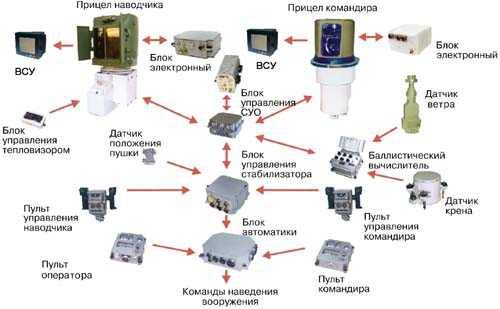
The armament stabilizer appears in the LCP BMP-2 - for the first time for light combat vehicles, thanks to this, the 30-mm cannon and machine guns paired with it are fired not only from the spot, but also on the move, the ATGM - only from the spot.
While the tanks were already equipped with laser range finders and ballistic computers with sensors for firing conditions, combat vehicles, for example, BMP-2, did not have them in their composition.
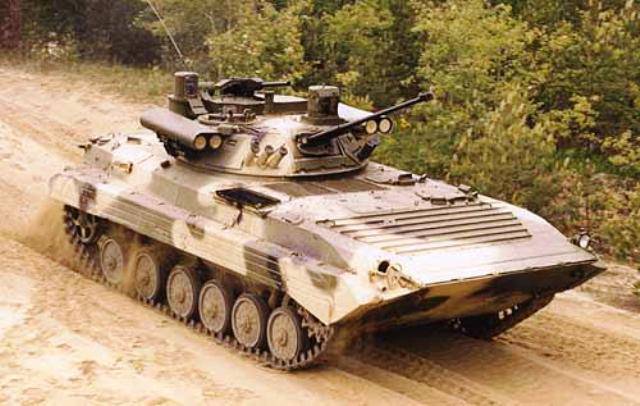
The lag of the fire control system and the BMP-2 armament complex as a whole from the current level is observed in several directions.
• The non-automated fire control system (LMS) of the BMP-2, which lacks an onboard computer, modern sights, an automatic tracking, does not allow accurate firing and limits the effective firing range of the 30-mm gun to the 1100-1400 distance. the required accuracy of stabilization of the line of sight is realized, which is implemented by the BOD-2-42 target rigidly attached to a weapon.
• The firing of guided weapons is only possible from the spot due to the wired communication line of the Konkur ATGM and the absence of a stabilized line of sight.
• Competition ATGM has a low firing rate due to the need to reload the launcher. In the process of reloading, great time losses occur and there is a danger of a rifle or a rifle gun armament charging the loader.
• Shooting at night can only be done with an automatic cannon and a PKT machine gun at a range of no more than 800 m.
• Shooting at an air attack using the 1PZ-3 foreshortening sight is essentially limited to creating a psychological effect: the probability of hitting a typical aerial target does not exceed hundredths.
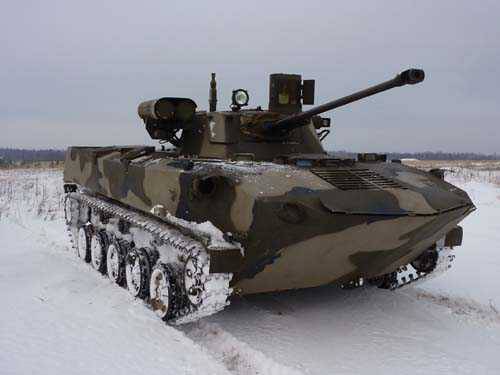
The adoption of the BMP-1987 infantry fighting vehicle for use in the 3 was a qualitative leap for light armored vehicles. The BMP-3 armament complex was created in the state unitary enterprise “Instrument Design Bureau”. In its composition and power of fire, it was unique, superior to not only serial, but also promising infantry fighting vehicles of all countries of the world. In its structure, the complex has 100-mm gun, 30-mm gun, guided weapons with a rocket fired from the barrel of the gun, and the FCS, the parameters of which were not worse than tank weapons, and in terms of size and cost - significantly less.
In the OMS, the BMP-3, unlike the BMP-2, was the first to use a gunner's sight with an independent line of sight, which allowed firing while the carrier was moving, not only with artillery, but also guided weapons, as well as an analog ballistic computer. In this case, part of the parameters entered it automatically, from the sensors: vehicle speed and course angle, angular velocity of the target in the horizontal channel, machine roll, distance to the target. To measure the range introduced laser rangefinder, which was installed on the barrel. For slowly changing parameters — air temperature and charge, atmospheric pressure, deviations of the initial velocity — manual input was provided. Thus, using the example of the development of the LMS BMP-1 - BMP-2 - the BMP-3, the convergence of the lines of development of the LMS of tanks and lightly armored vehicles, in particular the BMP, is traced.
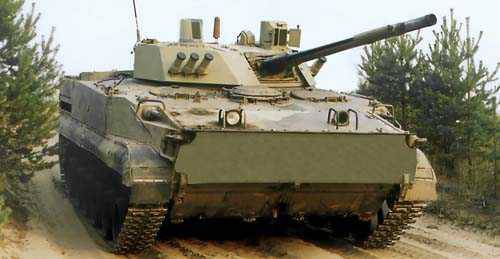
At the same time, the BMP-3 adopted for use more than twenty years ago had a significant reserve for increasing the tactical and technical characteristics. As part of the OMS of the BMP-3 armament complex, the improvement was carried out in the following main areas:
- ensuring effective combat use day and night, in adverse weather conditions and with smoke interference;
- automation of combat work, reducing the load on the crew in combat;
- Improving crew visibility by improving its sighting and observation complex;
- improving the accuracy of firing artillery weapons, ensuring effective firing at low-flying and low-speed aircraft and helicopters;
- ensuring the autonomy of the action in all combat situations and individual phases of the battle - during fire preparation of an attack, attack, repelling an enemy counterattack, including effective firing from closed firing positions.
A new step in the development of the OMS BMP was the SUO of the BMD-4 combat vehicle developed by GUP KBP.
The main components of the MSA were: the gunner’s combined day-night sights, the commander’s panoramic sight, a high-precision weapon stabilizer, a digital ballistic computer with a sensor system, a tele-thermal automatic tracking unit, see figure 2.
The OMS implemented new technical solutions.
• A combined gunner's sight has been developed with thermal imaging, target, laser distance measuring and information missile guidance channels, united by a single unit of the head mirror with high-precision two-plane stabilization of the line of sight. This makes it possible to detect targets at long ranges in motion, reliably accompany the target manually and automatically.
• A distance sight channel, constructively made in a single unit with a sighting channel, allows you to measure the distance to the target with a frequency of up to 4-5 Hz, which increases the effectiveness of firing at ground and, especially, at air targets.
The angle of divergence of the radiation of the rangefinder channel of the sight is reduced by 2 times, and the unit's unified design allowed the optical axes of the rangefinder and target channels to be misaligned during the entire operation of the device no more than 0,1 mrad without the use of alignment tools, which increased the likelihood of reliable range measurement and the range finder immunity.
• The problem of the limited capabilities of the commander in the search and detection of targets, duplication of shooting was solved by introducing into the control system the scope of the commander of a panoramic view with an independent two-plane high-precision stabilization of the visual field. This gave the commander the ability to search and reliably detect ground and air targets in the circular sector of the review on the horizon and up to + 60 vertically, the maximum angular velocity of the line of sight increased to 26 deg / s.
The new sighting system made it possible to increase the flow of targets detected by the combat vehicle 2,5 times, to increase the targeting accuracy to the gunner up to the 1 mrad not only along the horizontal, but also along the vertical channels.
The MSA implemented a complete duplication of the shooting process by the commander with all types of weapons, day and night, including guided weapons in the thermal image of the target, formed by the gunner's thermal imaging channel, on the display screen of the commander's sight.
• A tracking automaton integrated with the gunner’s thermal imaging channel and the commander’s television channel of the sight can improve firing efficiency due to the high accuracy (0,05 – 0,1 etc.) of tracking ground targets and airborne objects, as well as eliminating the psychophysical state of the operator and his qualifications on the results of the shooting. Accuracy of maintenance has become a technical characteristic that does not depend on the qualifications of the operator and stressful situations in combat conditions.
• The new weapons stabilizer increased the speed of pointing and introduced a digital control unit. This made it possible to implement new laws of control, improve the accuracy of stabilization of weapons and maximum guidance speeds up to 60 degrees / sec, ensure optimal operation of the tower and gun drives in various modes, and adjust the drives when used on various objects with different loads.
• The new digital ballistic computer 4ВХNUMXМ introduced in the BMD-1 armament complex in the BMD-539 armament complex provides accurate automatic generation of firing installations, makes it easy to program and reprogram an almost unlimited number of ballistics. A significant increase in the accuracy of firing an automatic cannon with all types of ammunition is ensured by developing an original shooting algorithm that most fully takes into account all the factors of firing: target range (measured by a laser rangefinder or manually entered), speed and direction of movement of the combat vehicle and target, wind speed, temperature and air pressure, charge temperature, deviation of the initial velocity of the projectile from the nominal value, elevation angle of the target, angles of heel and pitch, angles of departure of the projectile.
The effective firing range of the 30-mm projectile automatic cannon increases to 1800-2000 m.
• The BMD-4 anti-aircraft fires are significantly increased: the probability of hitting an automatic cannon when firing at typical helicopter, attack aircraft aircraft increases by more than an order of magnitude and approaches the probability of hitting a near-range anti-aircraft missile systems. less ammunition consumption. Thus, the principle of universalization of BM is successfully implemented by imparting anti-aircraft properties, and without additional costs.
• The problem of significant energy consumption and limiting the number of radiation cycles for ATGM launches was solved by introducing into the information channel laser diodes that do not require cooling, with higher efficiency, instead of a solid-state laser based on yttrium aluminum garnet with a cooling system. This solution allowed to dramatically reduce the size, power consumption.
A distinctive feature of the proposed MSA is a high degree of unification: it is possible to use various types of thermal imagers, including foreign-made, ATGM guidance modules; implementation of different ballistic unmanaged shells. The compact execution of the components of the OMS simplifies placement on various BM.
The modular construction of the LMS allowed the use of the prevailing part (up to 90%) of the control system of the BMD-4 control system in the upgraded BMP-2 control system: in the control system, the control channel PTU was replaced; due to lack of space, the sight of the commander is placed behind the tower. At the same time, the new SLA, implemented on the BMP-2, additionally made it possible to provide salvo-firing anti-tank guided missiles to destroy highly armored targets, to ensure the firing of an automatic grenade launcher and other weapons from the spot, on the move and afloat.
In addition, for the modernization of machines of a smaller weight category, for example, on the BMD-2, the SLA was used in an abbreviated version - only part of the SLA and part of the armament (gun and one launcher).
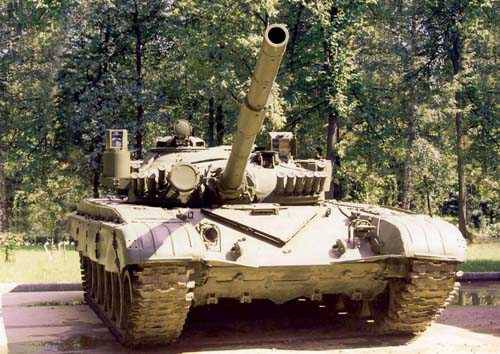
The OMS was also tested on the T-72 in the course of its modernization in one of the variants.
The unified automatic MSA has provided new weapon qualities to the armament complexes of combat vehicles:
- improving the accuracy of firing artillery weapons of BM, while increasing the effective range of 30-mm projectile to 1800-2000 m; the maximum firing range of 100-mm OB shells - up to 7 km; effective range of tank guns - 1,3-1,8 times;
- increasing the likelihood of an ATGM hitting the target, ensuring the firing of the ATGM on the principle of “fired-forgot”
- expansion of target reconnaissance capabilities, increase in the flow of detected targets in 2,0-2,5 times;
- ensuring full duplication of firing by the commander with all types of weapons; the use of a panoramic sight allows you to implement the principle of "hunter" and increase fire performance 1,5-2,0 times;
- an increase in the probability of hitting an air target over the span by more than an order of magnitude with a decrease in consumable ammunition, approaching the effectiveness of the BM anti-aircraft firing to the indices of specialized anti-aircraft missile-cannon complexes of the near frontier;
- ensuring firing from closed positions;
- the defeat of all modern and promising tanks by firing two URs with a volley in one beam (ATGM "Kornet"), ensuring the firing of ATGM with excess;
- ensuring ease of operation, the ability to quickly expand the range of weapons and ammunition used and navigate in a combat situation, improving the ergonomic characteristics of the BM.
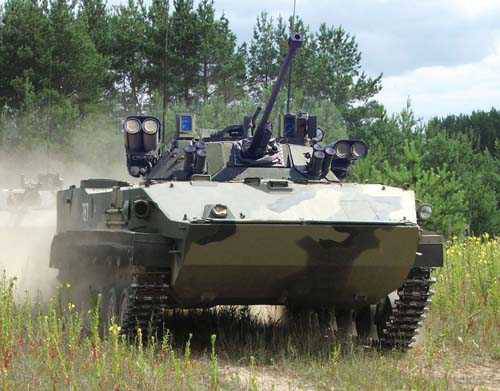
Thus, the introduction of a unified automatic day-to-day high-precision SLA can significantly improve the effectiveness of armament of armored vehicles and ensure the defeat of various nomenclature of targets in difficult meteorological and topographic and geodetic conditions, from space, afloat and afloat, day and night at all ranges of weapons.
This MSA can be used as part of armament complexes (fully or partially) in BMD-2, BMD-3, BTR-90, BMP-3, BMP-1, BMP-2, T-72, T-80, T- 90, as well as in weapons systems, installed on river and sea vessels.
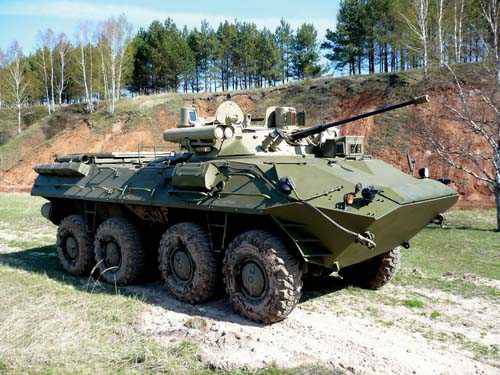
GUP KBP has been working on deploying weapons systems with a new MSA and on foreign customers: Patria (Finland), ASCOD (Austria) and FAHD (Egypt), and modernized BMP-2 controls - on Italian IVECO machines (see fig. 1).
At present, the proposed MSA is serially produced by the state unitary enterprise “KBP” and, upon the customer’s requests, can be installed on various combat vehicles.
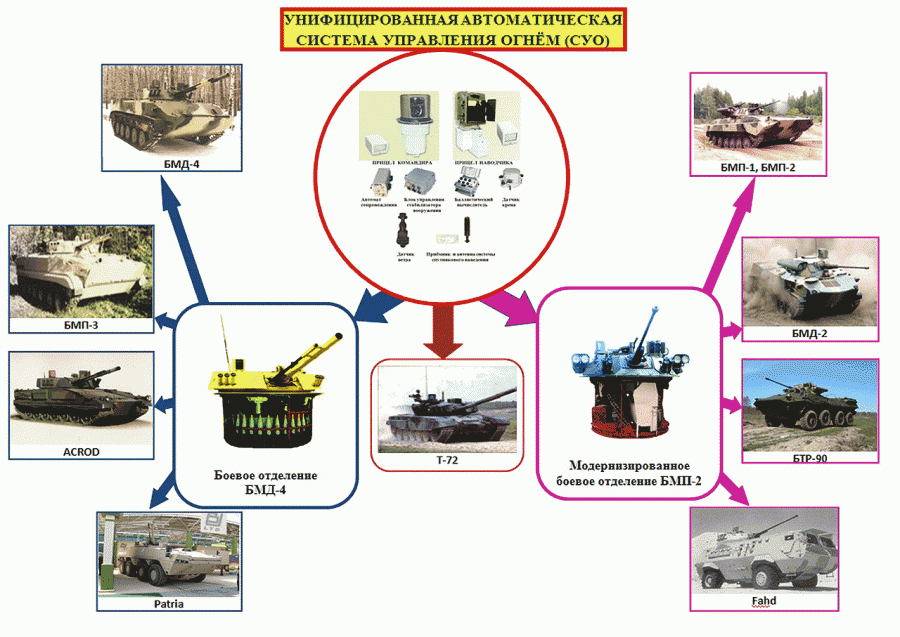
Information